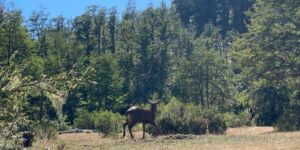An huemul in Lanín National Park has crossed from Chile to Argentina and was sighted in the vicinity of Lake Queñi.
After 30 years of absence, the huemul has returned to Lanín National Park. Today, spokespersons for the protected area have announced that an individual crossed from Los Ríos, Chile, to Argentina, being observed in the vicinity of Lake Queñi, about 50 km west of San Martín de los Andes.
“This is a significant milestone in the conservation of this emblematic species of the Andean region. This news is an important achievement for the conservation world of an endangered species, thanks to the collaboration between Huilo Huilo Biological Reserve (through its Huemul Reproduction and Reintroduction Center, led by the Huilo Huilo Foundation) and the agents of Lanín National Park,” stated the Institution.
They have been working for several years to make the presence of the huemul in Lanín National Park a reality. They began working hard to favor the return of huemules through a project that complements the efforts made since 2005 in the Huilo Huilo Biological Reserve in Chile, where they managed to breed and reintroduce huemules in the Los Ríos Region, where they had become extinct.
For their conservation, the Huilo Huilo Foundation initially captured two huemul specimens (Hippocamelus bisulcus) and released them in 70 hectares of native forest and scrubland within the reserve. At the end of 2005, the first offspring was born in a controlled environment and, in 2016, they achieved another milestone: the first reintroduction of the species. That year, the huemul returned to inhabit the wild in the Los Ríos Region, after 30 years of extinction in the area.
With this successful experience as a reference, Lanín National Park has intensified one of its top priorities in the last two years: the eradication of feral livestock (animals without tags or marks that have become wild).
These efforts have already shown positive results in the recovery of the environment in the Lake Queñi area, where the huemul specimen was sighted.
“This reunion symbolizes not only the resilience of native wildlife, but also the firm commitment of the institutions that make up the Huemul Project (National Parks Administration and Huilo Huilo Foundation) to protect and restore the natural heritage of the area.
With the technical and scientific information shared in the area, effective strategies have been implemented to reverse the decline in huemul population. This success is the result of 20 years of work and joint effort between Huilo Huilo Biological Reserve and Lanín National Park, collaborating closely under the project framework,” added those from the protected area.

Biological Corridor
Lanín National Park and Huilo Huilo Biological Reserve, located in the Los Ríos Region, form a natural biological corridor. This has motivated both institutions to join forces to recover a species that, around the 1980s, became extinct in the Region of Los Ríos and in the province of Neuquén.
From Lanín park, they affirm that the presence of the huemul in Neuquén territory “inaugurates a new stage in its recovery, inviting to reinforce conservation actions to prevent this achievement from regressing.” They also added that the Queñi area, where the huemul was seen, will remain closed to public use until further notice. They reminded visitors and locals of the importance of not bringing pets into the national park.
Due to their numerical decline and the shrinking of their distribution area, the huemul has been classified as an endangered species. In Argentina, the National Congress declared it a “Natural Monument,” the highest legal protection status that can be given to a species in the country.
In addition to what is currently happening in Lanín National Park, the experience of the Huilo Huilo Foundation has been replicated since August 2022 at the Huemules Shoonem Rehabilitation and Rearing Station, the first breeding center for these animals in Argentina, located in the town of Alto Río Senguer, about 320 km south of Esquel. It is estimated that of the 2500 huemules remaining in Patagonia, about 500 live in Argentina and the rest in Chile.
Huemul in Lanín National Park
Researchers from CONICET and the National University of Comahue have highlighted the high prevalence of osteopathology in this endangered species.
In Argentina, it is estimated that there are about 500 huemules distributed in 50 different groups, while the rest are in Chile, along 1800 km of the Andes. Despite the efforts, the species situation continues to worsen over time.
There are reasons to believe that the distribution of the huemul was much broader in the past. The main cause of its extinction has been the human encroachment on the areas inhabited by these animals. One problem is that huemules are almost unafraid of humans, making them very easy to capture. There are descriptions indicating that they were hunted with stones and sticks. For this reason, today they are only sheltered in remote areas of the mountains, difficult to access.
Have you visited our YouTube channel yet? Subscribe now!

